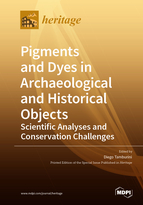Identification of Pre-1950 Synthetic Organic Pigments in Artists’ Paints. A Non-Invasive Approach Using Handheld Raman Spectroscopy
Round 1
Reviewer 1 Report
The paper is interesting, well written and very clear. I would suggest only to improve some parts related to the specific Raman instrument: the phenomena of overexcitation should be better described in a more technical way, while it is not clearly highlighted why the methodology of acquiring spectra at different wavelegths and their averaging should improve the fluorescence. The handheld Raman spectrum in Figure 2 seems presenting some artifacts in terms of bagckground substraction: this should be mentioned or explained. Finally, there are also some text errors (for instance, repetition of spacing).
Comments for author File: ![]() Comments.pdf
Comments.pdf
Author Response
Dear Reviewer,
We would like to thank you for the time in reviewing our manuscript.
In the following we would like to answer the two central questions that were raised and comment on the minor changes.
Regarding the comment on providing more information on the acquisition and processing of the handheld Raman spectra with the Bravo software, I am afraid that we can not give more information. The software that is used to reduce fluorescence is a patented algorithm. We have tried to summarise in this article all the information available to us from both the patent and related publications, and have also been in contact with the company itself. Unfortunately, this is all information that we can provide at the moment.
Thank you for the comment about the artifacts in figure 2. We have added a sentence to the manuscript pointing this out.
We have tried to find more information about the phenomenon of overexcitation and peak shifts in phthalocyanine pigments. The articles we named as sources describe the phenomenon and also make assumptions about the cause, but do not give a precise explanation and unfortunately, we could not find more detailed information. However, we added a sentence to the manuscript, giving detail information from source [29]. Here, Fremout et al. (2012) describe that the cause is unknown and what they assume to be the reason.
Following these changes, we have also carefully reviewed the text for format and spelling errors and made improvements.
We would like to thank the reviewer once again for the time and effort in revising this manuscript and look forward to submitting an improved article.
Best regards,
The authors
Reviewer 2 Report
Good presentation of analysis and methodology. I like the comparison of handheld and in situ instruments, along with acknowledgement of value/limitations for GC and LC analysis. Spectra in figures are clear and annotated well. This is a useful contribution to the expanding literature on synthetic materials and addresses possible analyses for these pigments as well as potential limitations re: binder and mixtures.
Minor changes to English suggested, overall perfectly understandable but there are some small errors with grammar and punctuation that can be made for better presentation. One example throughout is "pre-1950" rather than "pre1950". Not all section headers (Instrumentation, etc) are formatted consistently. Recommend superscript for cm-1. I have added some comments to the PDF as examples of the suggested revisions, though not every instance is highlighted.
Comments for author File: ![]() Comments.pdf
Comments.pdf
Author Response
Dear Reviewer,
We would like to thank you for the time in reviewing our manuscript.
Following your suggestion, we have had the manuscript proofread by a native speaker and revised it accordingly.
Thank you for your careful and attentive reading of the headers. We have checked them for consistency and made improvements, as well as for the spelling of cm-1 to cm-1.
Furthermore, all comments concerning the text errors have been accepted and detailed information about BON pigments has been added.
We would like to thank the reviewer once again for the time and effort in revising this manuscript and look forward to submitting an improved article.
Best regards,
The authors






